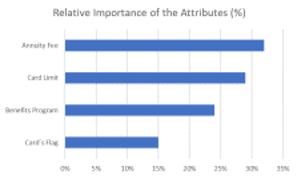Article written by Dario Sales and Henrique Souza and published in the Journal of the Professional Pricing Society (PPS).
Customer perception-driven pricing has become an important tactic to pricing in numerous businesses. A dominant methodology for this approach is Conjoint Analysis, a research method that contemplates a cohesive understanding of a costumer´s preferences and purchasing decisions. Any product or service consists of a bundle of attributes that a costumer jointly considers when making a decision. Because it is a method that seeks to understand the preference of one attribute in comparison to others, a keyword for this analysis is the term trade-off.
In previous projects, we have applied Conjoint Analysis and came to several findings that were not only common sense to our clients, but also had great potential to generate business value through pricing strategies. We highlighted a project that showed a different willingness to pay across different segments for the main product of our client´s portfolio, thus allowing to capture more value from the segment that was less price sensitive for this solution.
Another case pointed out that one of the most valued attributes by the business´s management was not so valued by the customer. The action plan was to work on the product´s communication in order to create value for this attribute and, by applying future research, we were able to charge for this specific attribute. Finally, another interesting case was about whether the firm´s technical assistance was valued by its customers to be set as an additional charge. The study found that in general customers valued this attribute and captured how much they were willing to pay for it. The action plan was to add technical assistance to the company’s offer and grant discounts to those customers who did not value this service, instead of charging an additional fee to those who valued it.
One can tell from the examples above that there are several ways to work with the results of a Conjoint Analysis and generate value for a company. However, an important question still remains, how can we translate this powerful tool into business added value? First, we will go through the concept behind this study and then we will proceed with a structuring and application guide.
While there are other research techniques that also seek to understand the perceived value of products or services, the Conjoint Analysis method indirectly addresses the costumer and therefore bypass biases from direct research methods that make it harder to correctly model consumer choice behavior. For example, a research on credit card preferences could address the “annuity” attribute by asking if a low annuity rate is important to the customer. Most likely, following this rationale, the answers to any attribute would always be “very important”. However, if the question relies on the comparison of low annuity rate and credit limit over $10,000, which one is more important? In this case, we would work the respondent´s tradeoffs.
There are various Conjoint Analysis methods one can use, such as Choice-Based Conjoint (CBC) or Conjoint Value Analysis (CVA). The first, CBC, is the most common method for pricing purposes. In many literatures, it is also known as Discrete Choice Modeling (DCM). The use of each will depend on the characteristics of the product or service, sample size, number of attributes raised and how the survey is going to be applied. In general, these methods can answer in different ways many questions related to pricing. Among them, the following stand out:
– Relative importance of the attributes: What are the most relevant attributes of a given product or service?
– Market segmentation: How do different customer groups perceive a given attribute?
– Evaluation of new attributes / services: Does it make sense to include a new attribute in a product / service package?
– Price sensitivity and price range suggestion: What is the price range that the costumer is willing to pay?
– Competitive positioning: How do costumers perceive our product or service compared to the competition?
Structuring the study, as well as the application of the research, however, is a critical point for obtaining results with greater accuracy and confidence. The following is a step-by-step guide to help you build a well-designed Conjoint Analysis:
- Attribute and level selection
In order to select the attributes to be analyzed, best practices suggest in-depth interviews with the client’s management team or professionals from the industry in question. Going back to the credit card example which discusses consumer preferences when purchasing a card, we could raise a number of attributes, such as: a) annuity fee; b) card´s interest rates; c) credit limit; d) benefits program; e) card flag; f) card´s premium level; g) call center; h) card acceptability; i) ties with philanthropic institutions, among others. These attributes may have more than two levels of response, as is the case with the benefits program, which may be a Mileage Program, Insurance Coverage, Concierge, among others. However, literature references suggest choosing at most between six and seven attributes. Above this number, it is difficult to keep the respondent motivated to answer the survey as it becomes lengthy and complex, a matter further discussed in more detail in the following topic. The researcher should also avoid inaccurate or subjective criteria for defining the levels of each attribute, such as low, medium and high. For instance, a low annuity for one respondent may be an average annuity for another.
To better understand how the number of attributes and levels impact a Conjoint Analysis, let’s take an example of a 4 attributes survey with 3 levels:

This format can generate 81 different types of combinations (3x3x3x3). However, for this analysis an orthogonal design approach is used, using statistical software such as SPSS, Minitab, Sawtooth, which reduces the number of combinations to the minimum possible. In this case, the profile combinations could be reduced to 16. These profiles are also called cards. An example card can be seen below:

This set of minimal combinations enables the measurement of what is referred to as main effects, when the levels of the same attribute are relativized, not considering the interactions between different attributes. Consequently, each attribute would have its utility or perceived value estimation and it would show the relevance of each of the levels for each attribute. For example, considering that the benefits program contemplates one of the following three benefits: mileage program, insurance coverage or concierge. The main effect chart would show the utility for each of these benefits in the respondent´s view. The results for this hypothetical example will be shown on the last topic of this paper.
- Metrics for establishing the results
As mentioned, Conjoint Analysis research is used to understand consumer preference or purchase intent. Thus, the methodology requires respondents to rate the options shown by either grading them or sorting their preferences. The first uses a metric scale, in which the respondent rates the cards independently, ranging for example from 1 (would certainly buy) to 5 (would never buy). The second approach is known as ranking, in which the respondent ranks the cards according to his preference. The latter is considered more reliable, but as the number of profiles to be sorted increases, it becomes more difficult for the interviewee to fully differentiate them because the combinations become more alike. Therefore, for a high number of profiles, the metric scale approach may be more appropriate. Another form of contingency for a research with a high number of profiles is the adaptive conjoint method. It is a software-based modality that, based on the initial answers, the tool adapts to the respondent’s preferences and can eliminate unnecessary questions, thus reducing the survey time.
- Survey application and its sampling
Literature references show that samples for Conjoint studies range from 100 to 1,000 observations, most commonly from 300 to 500. In any case, it is of utmost importance that profiles or attribute cards are presented very clearly and simply. The application of the survey through personal interview is indicated. However, it takes longer and it is more expensive. If applying via online survey platforms or by any method that does not involve the presence of the interviewer, it is important that pre-testing be done internally as well as with potential respondents.
It is important to measure the response time during the pre-test. Since it may be a complex survey, it is common that the time required for answering is longer than what the respondents are accustomed to, and this can lead to withdrawals. In addition, a relevant step before applying the survey is to segment it according to the purpose of the study, so it is possible to evaluate behaviors and trends by various criteria, for example, by socioeconomic profile or by region.
- Validation of results
There are a few ways to validate the answers from the survey, among them we highlight the creation of a profile with the worst levels of each attribute. Going back to the credit card example, it would be a profile with the most expensive annuity rate, the lowest credit limit and all the other attributes being negative. If the respondent ordered this profile as preferred or would certainly buy, it is evident that there was no discernment at the time of choice, resulting in an invalid answer. However, there is no need to create an additional profile to test the integrity of the response in case there is an objectively less desired profile than another.
Results
The following are hypothetical examples of how we view the results of a Conjoint study. The first and second graphs show the interaction of the main effects, that is, of each attribute independently. The graphs show the utility between different levels of the same attribute, which in this example is the credit card benefits program. What sets them apart is the socioeconomic segmentation.

Results show that respondents with an income below $3,000 perceive insurance coverage as more valuable than a mileage program and concierge. For a wealthier respondent, the mileage program becomes more relevant. In both cases, the concierge attribute has the least relevance in decision making.
The following chart is also one of Conjoint’s results and shows the relative importance of each attribute. In this hypothetical example, we highlight the importance of each attribute when purchasing a credit card.

The Utility functions and the relative importance of the attributes allows many considerations about consumer behavior without the need to ask detailed questions about each attribute. It is a reliable technique that can replace traditional customer satisfaction or Voice of the Customer (VOC) surveys. This study has the ability to demystify the customers´ trade-offs, thus supporting management with great strategic tool. However, medium and long-term strategic business awareness is essential, which are often not derived solely from research or quantitative analysis. A clear strategy is very important to address planning, assembly and application of research methods.


